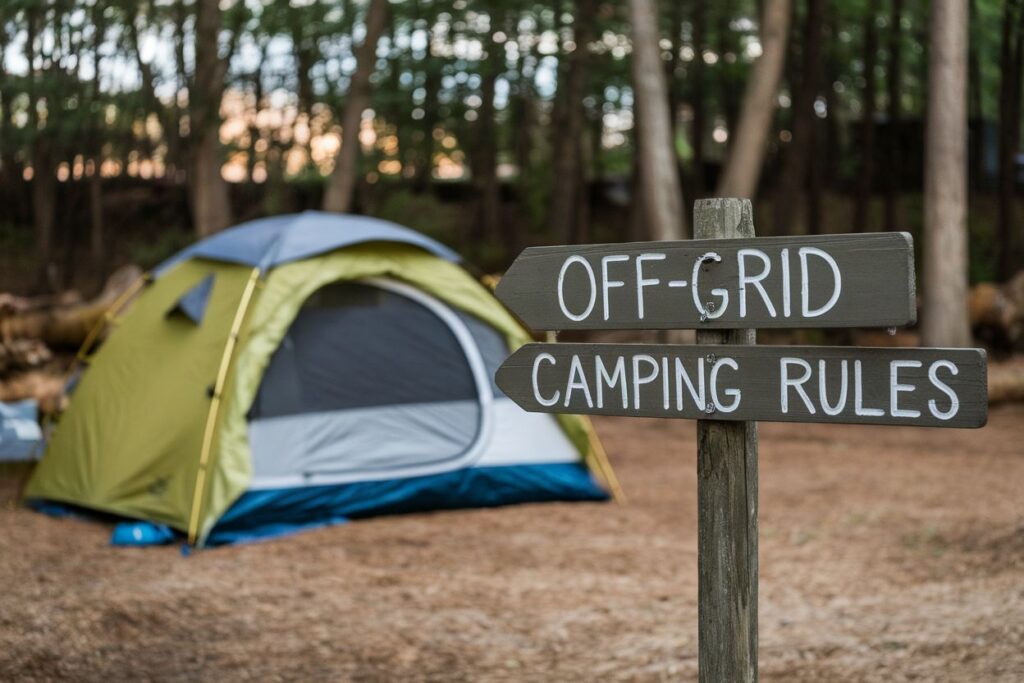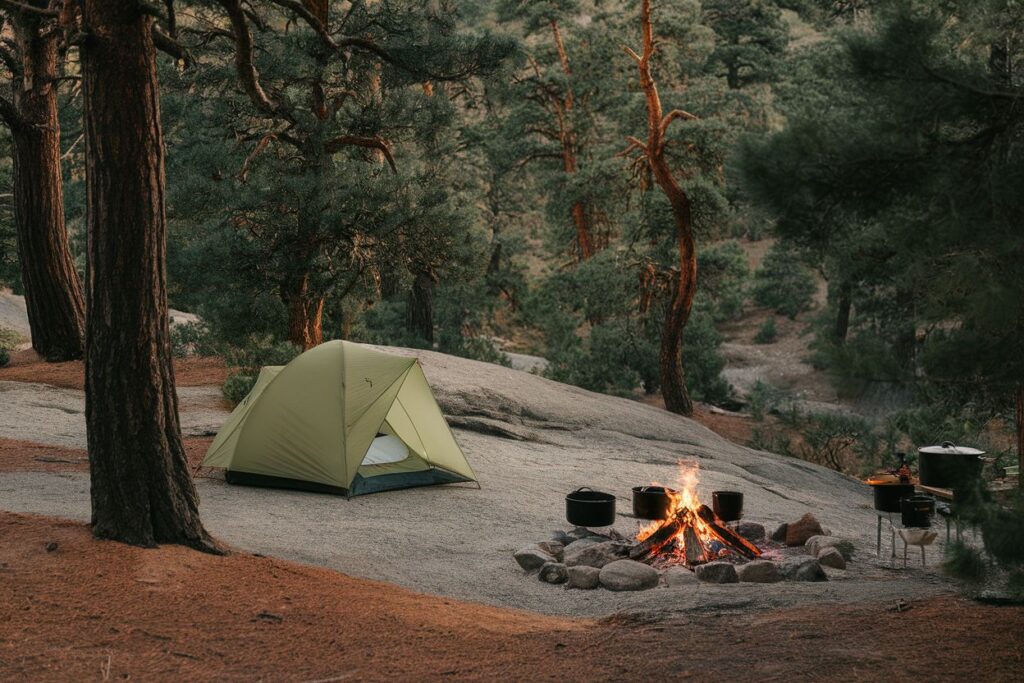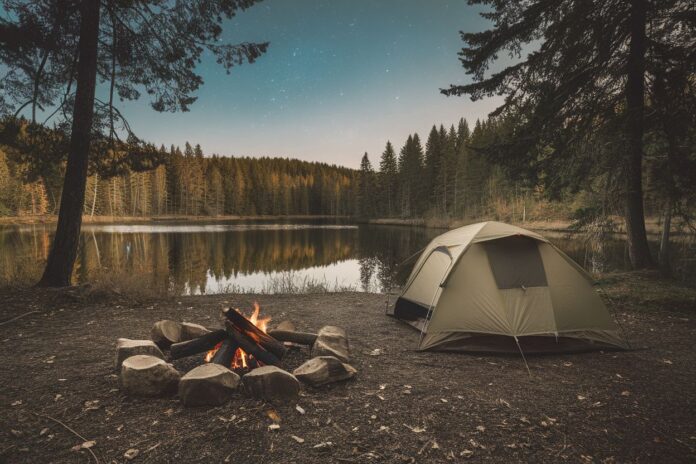Off-grid camping lets adventurers escape city life and dive into nature. It’s a chance to explore the untouched beauty of the United States. You can wander through dense forests or vast deserts.
Backcountry camping fans love finding quiet spots away from busy campsites. This guide will show you how to find these hidden gems. They offer peace and exciting adventures.
Finding secluded camping spots needs knowledge and planning. Whether you’re a pro or new to camping, we’ve got you covered. We’ll teach you how to find amazing off-grid places.
Planning is key for a successful remote camping trip. Use online tools, maps, and expert tips to find stunning spots. You’ll avoid crowded areas and find hidden treasures.
Going off-grid means thinking about the terrain, how to get there, and the weather. This guide will help make your camping dreams come true. Get ready for unforgettable adventures.
Understanding Off-Grid Camping Essentials
Wilderness camping is different from regular camping. It needs special skills and the right gear. You must plan well and know how to survive in the wild.
Basic Requirements for Remote Camping
Remote camping is tough, even for experts. You must be self-sufficient. Knowing your surroundings and how to navigate is key.
It’s not just about the gear. Knowing what to do in emergencies is just as important.
Safety Considerations and Preparations
Staying safe in remote areas is all about planning. You need to know how to navigate, handle emergencies, and understand the terrain. Carry devices to communicate, learn basic first aid, and stay alert.
Essential Gear and Equipment
Choosing the right gear is crucial for off-grid camping. You’ll need good water filters, multi-tools, strong shelters, emergency comms, and cooking gear. Your gear should be light, versatile, and reliable.
Skills like starting fires, building shelters, and navigating are essential. Spend time learning and practicing these skills before heading into the wilderness.
Best Tools and Resources for Finding Remote Camping Locations
Today’s adventurers have many digital tools to find secret camping spots. Camping apps like Campendium and The Dyrt have changed how we explore the outdoors. They offer detailed info on remote campsites, along with reviews and exact locations.
Topographic maps are still key for camping off the beaten path. Now, digital maps mix old-school maps with satellite views. This gives campers detailed terrain info. GPS devices have also improved, offering real-time directions and exact locations in remote areas.
“Technology has transformed wilderness exploration, making remote camping more accessible than ever before.” – National Outdoor Recreation Association
Satellite images are a big help in finding camping spots. Google Earth and similar tools let you explore areas online. You can spot campsites and understand the terrain before you go. Many outdoor experts use apps, GPS, and satellite images to plan their trips.
Professional tip: Always download maps and satellite images offline before heading into areas with no cell service. This way, you’ll have the navigation info you need when you’re far from home.
Legal Considerations and Land Regulations

Off-grid camping comes with legal rules to follow. You need to know about public land use and environmental rules. This knowledge helps ensure a safe and respectful camping trip.
Public Land Access Rules
Public lands are managed by different agencies, each with its own camping rules. National Forests, BLM areas, and National Parks have specific guidelines. It’s important to check these rules before your trip to avoid fines or legal issues.
Permits and Restrictions
Some places need wilderness permits for camping. These areas might limit visitors, have specific camping zones, and set time limits. Places like Yellowstone or Grand Canyon National Parks often require reservations and strict permit rules.
Leave No Trace Principles
Protecting nature starts with personal responsibility. The Leave No Trace principles help campers reduce their impact. This includes disposing of waste properly, respecting wildlife, staying on trails, and leaving the campsite as you found it. These actions help keep ecosystems healthy and preserve wilderness for others.
Top Strategies for Discovering Hidden Off-Grid Camping Spots

Finding secluded campsites needs smart wilderness navigation and exploration skills. To start, understand the landscape and use special resources to find remote spots.
Digital mapping tools have changed how we find hidden camping spots. Apps like Gaia GPS and OnX Backcountry give detailed maps. They help find secluded spots in national forests and wilderness areas.
“The most memorable camping experiences often happen where few have ventured before.” – National Geographic Outdoor Explorer
Local ranger stations are key for wilderness navigation. Rangers can suggest hidden camping spots, share trail conditions, and offer tips on remote areas.
For finding off-grid spots, study satellite images and check different maps. Also, join local outdoor groups on social media. They often share secret camping spots for true backcountry adventures.
Always check local land management rules before you go. Some areas need special permits or have access limits that could change your plans.
Final Thoughts
Off-grid camping is a life-changing outdoor adventure. It connects people with America’s untouched wilderness. Exploring remote spots is more than just fun—it’s about learning nature’s secrets and survival skills.
To have a successful wilderness adventure, you need to prepare well. You must follow environmental rules and care for nature. Choosing the right gear and knowing how to use it are key. Off-grid camping teaches you to be self-reliant and solve problems.
Exploring responsibly means knowing local laws and following Leave No Trace. It’s about treating nature with respect. Whether you’re experienced or new, off-grid camping offers personal growth and freedom that regular camping can’t match.
When planning your next adventure, remember to bring preparation, respect, and curiosity. The American wilderness is ready for those who dare to explore. It promises an unforgettable nature connection.










